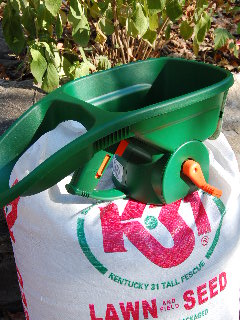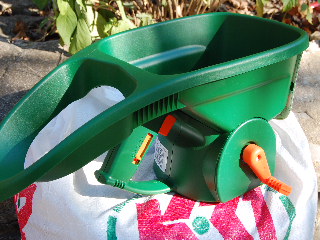
Spreaders for applying seed, fertilizer, and other gardening products come in a variety of styles and sizes.
For the commercial user who is charged with caring for many acres or sites of green, a large rotary spreader that mounts behind a tractor and works off the PTO drive of the vehicle is necessary.
Stepping down in size to products appropriate for the average home gardener, two basic types of walk-behind spreaders are available.
These are the drop-type spreader (which does just that, dropping the seed or fertilizer straight down to the ground covering only the width of the spreader itself as it is pushed), and the rotary-type spreader (which uses an impeller to fling the granular product outward over an area of several feet as the operator pushes the device along the ground).
However, for purposes of this discussion, we will address the merits of a smaller, easy-to-use handheld spreader—specifically, the Scotts® Handy Green® II.
This little spreader is built around a hopper (approximately 7” by 8” by 5” deep) into which the seed or fertilizer is placed while the spreader is setting on a flat surface with the trigger closed to prevent discharge of the material until you are ready. The claim is that the hopper holds enough Scotts® product to cover about 1,000 square feet. (I would think there is some variation in this depending on the exact product you’re using at the time.)
The spreader is held by placing your left hand and wrist through a handle that allows you to grip a trigger-like mechanism which controls the on/off flow of material out of the hopper. The ergonomic design of the handle is said to make for minimal strain and fatigue to your wrist. This indeed seems to be the case, as the underside of your arm is actually providing a counter-balance to the weight of the material in the hopper.

A small gauge on the right side of the trigger mechanism allows flow settings from maximum (setting no. 5) to minimum (setting no. 1) to control the density at which material is added to your lawn.
When one is ready to use the spreader, the steps are: load the spreader while it is setting on a stable flat surface, select the proper calibration for delivering material, place left wrist through handle and grip trigger, begin walking and turning the small handle on the right side as you pull the trigger to begin discharging the material.
The fertilizer or seed will be distributed outward to the front and the left side for a distance of about 3 to 4 feet, depending on how vigorously you turn the crank. (Material is blocked from exiting the right side so as to keep the crank and your right hand clean.)
Remember to let off the trigger as you stop walking so as not to allow the continued flow of material from the hopper.
Try to walk in a straight line (choose a “target” at the end of your path), and observe closely how far out your seed or fertilizer is being thrown as you walk. This will allow you to make your next pass in such a way as to just slightly overlap material from the previous pass.
The pluses of this little spreader are that it is lightweight, causes minimal user fatigue, plastic (no metal to corrode), easy-to-use, easy-to-clean, easy-to-store, rather inexpensive, and a multi-purpose spreader (use it to spread ice melting products in the winter).
Just enjoy its ease of use, wash it up and hang it on the garage wall until next time, and be glad these smaller (but efficient) gardening tools exist for your convenience.
 Spreaders for applying seed, fertilizer, and other gardening products come in a variety of styles and sizes.
Spreaders for applying seed, fertilizer, and other gardening products come in a variety of styles and sizes.
 A small gauge on the right side of the trigger mechanism allows flow settings from maximum (setting no. 5) to minimum (setting no. 1) to control the density at which material is added to your lawn.
A small gauge on the right side of the trigger mechanism allows flow settings from maximum (setting no. 5) to minimum (setting no. 1) to control the density at which material is added to your lawn.